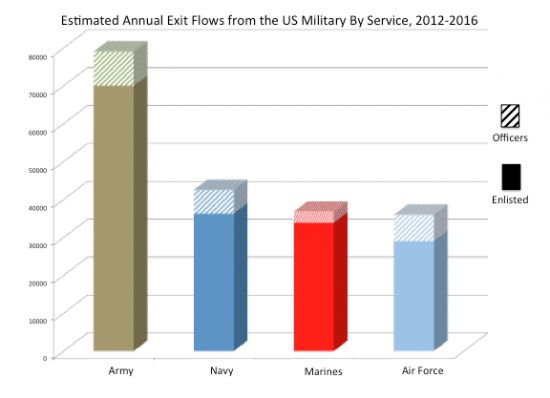The clean energy community and the U.S. veteran community are facing the opportunity of a century.
As we pause to observe Veteran’s Day 2013, a confluence of four factors is creating new opportunities for men and women in uniform. These include the growing personnel exit from the U.S. military; the drive, leadership and execution skills gained by veterans in operational deployments; national education and training support for veterans in the form of the post-9/11 GI Bill; and the growing workforce demands of the clean energy sector. Together, these factors have the potential to form a unique jobs pipeline from one workforce to another.
Many veterans have gained valuable leadership experience, discipline, problem-solving skills, and the ability to work as a member of a team while deployed in operations around the world -- particularly the conflicts in Afghanistan and Iraq. Whether conducting patrols, coordinating with local village leaders or helping build local infrastructure, the “get-it-done” skills of this particular group of veterans run deep. Companies value these skills, which also serve as the entrepreneurial foundation for many startup companies.
In addition to their intangible skills, many veterans bring distinct technical skills to the civilian workforce that were gained in military courses. For example, these could include an Air Force communications sergeant, an Army combat engineer or a Navy nuclear submarine officer. With so many military specialties, translating military technical training certifications to civilian opportunities could be a boon for employers across the clean energy community.
Most importantly, many veterans desire to continue serving the United States, and more are beginning to view the clean energy workforce as a way to contribute to the resilience and national security of the United States.
Every year, a number of the U.S. military’s 1.4 million uniformed members return to the civilian sector as veterans. Aggregate analysis shows that approximately 200,000 officers, noncommissioned officers, and junior personnel leaving the military annually. This exit flow has the potential to power coming growth needs in the clean energy workforce.

Growth in the U.S. clean energy workforce
The clean energy workforce is expected to grow significantly in the next five years. While forecasts vary by sector, the trend line is clear.
A November 2012 report from The Solar Foundation found that there are currently 119,000 workers in the solar industry, with the potential to grow to 285,000 by 2016. Similarly, a 2012 NREL report found that 12,000 to 14,000 new workers would be needed annually in the wind industry between 2015 and 2018, growing the workforce from 40,000 today to over 90,000 in 2020. Other subsectors, including energy service companies (ESCOs) and the energy data/analytics sector, lack specific projections, but expect similar trends. A recent Navigant research report found the U.S. ESCO market set to nearly double from $4.3 billion in 2013 to $8 billion annually by 2020.
Integration services such as energy finance, management, consulting and policy positions will all require talented individuals. The challenge is no longer growing the industry, but ensuring that it has a trained and capable workforce. A bridge that connects military veterans to the clean energy workforce is needed.
The connecting pathway: The post-9/11 GI Bill
The post-9/11 GI Bill, officially known as the Post-9/11 Veterans Educational Assistance Act of 2008, includes numerous financial support options for veterans who have served 90 days after September 10, 2001. These options include:
- Graduate and undergraduate degrees
- Vocational/technical training
- On-the-job training
- Flight training
- Correspondence training
- Licensing and national testing programs
- Entrepreneurship training
- Tutorial assistance
The options are broad enough that veterans are often able to pursue a pathway of their choosing. Similarly, many options provide support funding for both tuition and a housing stipend while enrolled. This double layer of financial support provides further flexibility to veterans.
Growing exits of veterans with diverse technical skills and a strong post-9/11 GI Bill are creating a pipeline of human capital for the clean energy industry.
It is up to the clean energy sector to take advantage of this pipeline. Some clean energy companies will hire veterans due to their leadership skills alone, others because of their unique military technical skills, and still others due to their post-9/11 GI Bill-supported education or training.
Savvy companies could segment the veteran human capital market based on the types of positions they wish to fill, clearly communicating whether they are looking for all veterans or are focused on specific skill sets. Astute clean energy companies should place a veteran with their HR department to help match veteran talent to their company workforce expansion plan. Similarly, established companies could create developmental programs that allow veterans to continue to work while pursuing education and training opportunities supported by the post-9/11 GI Bill.
This horizontal pipeline of human capital will continue to mature over time. As it does, industry trade associations and clean energy companies should seek to build stronger relationships with universities, community colleges, and vocational training centers to ensure they have access to the latest veteran clean energy talent into their ranks.

The veteran community, with its ingrained leadership, problem-solving abilities, and diverse technical skills, is looking for new careers that contribute to the resilience of the United States. Together, the integration of veterans into the clean energy field, facilitated by the support of the post-9/11 GI Bill and education and training centers, form a horizontal pipeline of talent -- and the opportunity of a century.
***
Michael Baskin served as a U.S. Army infantry officer from 2002-2008 with 27 months of service in Afghanistan and Iraq. He holds a BS from the U.S. Military Academy at West Point, completed an MA abroad under the post-9/11 GI Bill at the Interdisciplinary Center (IDC) in Herzliya, Israel, and is a doctoral candidate at The Fletcher School of Law and Diplomacy at Tufts University.



